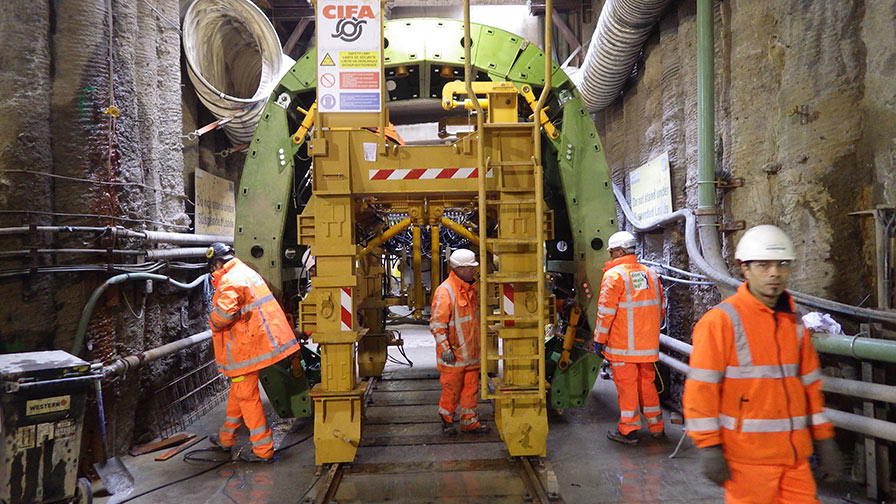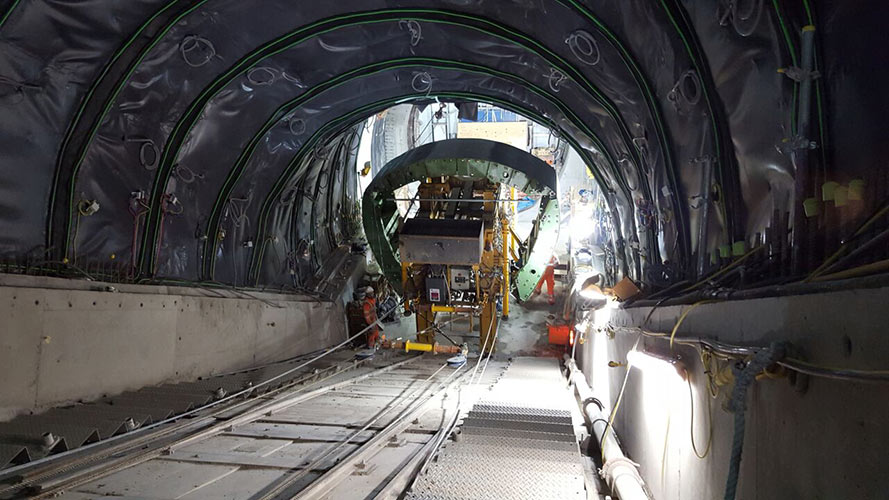Flexible formwork solution for multi-profile lining 16 Oct 2015
An innovative and highly flexible solution is being implemented to tackle the multiple geometries of formwork required for the £741 million upgrade of Victoria Station in London.
As part of the upgrade, the complex network of passenger tunnels below the deep-level underground station require various changes to their sectional profile, and in such a way that the secondary lining must consist of numerous geometries and profiles across the extent of the project.
Following a series of negotiations with some of the best-known European competitors in the field of steel moulds for in-situ casting, the BAM Nuttall/Taylor Woodrow JV (BNTW JV) awarded to CIFA of Senago the entire steel formwork supply contract.
The company secured the contract by proposing an innovative and highly flexible technical solution that could be transformed onsite to accommodate the changing formwork profiles. The solution was based on flanged formwork built using various radii with minimum deflection tolerances, coupled with a single carriage featuring a dual longitudinal length configuration and a variable height with different configurations.
Giovanni Esposito, Underground Area Manager for Europe, explained that CIFA provided a formwork consisting of three elements, with a total length of 5m. The formwork, he said, could be adapted to all seven sections of the network and transported by a 6.85m-long motorised carriage travelling on rails.
The added difficulty of moving the equipment along the narrow curves of the tunnels is overcome by creating a bespoke system that allows for the carriage to be shortened semi-automatically by up to 3.5m by removing the longitudinal extensions, thus configuring it for the transport of just a single element of formwork.
The problem of the different heights is overcome using telescoping legs with removable flange trunks and supplementary external lifting cylinders. These solutions allow for the pre-assembled carriage to be lowered in the shaft in a reduced configuration, as well as for each 1.67m ring of the formwork (weighing about 4.6 tonne each) to be transported to the first and narrowest opening (PAL22).
After completion of the transport phase, the carriage was extended semi-automatically in the vicinity of the first tunnel and loaded with the three rings weighing approximately 14 tonne in total. The casting phase then commenced for the various sections, with adaptations being made to the regularity of the profiles, which were in line with the tolerances specified by the designer.
An equally effective system was established for the casting of the escalator incline on a slope of 30°. A system of pulley cables fixed to a 7.5 tonne winch and an anti-tipping counterweight allowed the carriage to operate safely for both the transportation and positioning of the casting moulds.
One particularly challenging aspect of the work was the transition sections – those situated between the horizontal upper and lower chambers, and the 30° inclined escalator barrel. The complex three-dimensional change in geometry resulted in these transitions having multiple radii in both the horizontal slope and inclined planes, resulting in a multifaceted trapezoid shape with a variable cross-section. The adaptable shuttering system developed by CIFA allowed BNTW to construct the transition sections using the same traveller, and bespoke shutters simply fitted to it onsite.
Complex 3D changes in geometry required a multifaceted trapezoid shape with a variable cross-section
Along with the clever formwork design, the developed solution included a procedure for handling the geometric and structural details of each piece of formwork, as well as transporting and positioning the formwork to complete the casting.
The solution was implemented onsite using a forklift secured by cables connected to a winch located in the upper chamber, allowing safe passage of the formwork through the upper transition and down the escalator incline. The formwork, designed by Giovanni Esposito of CIFA, was symmetrically adaptable – allowing it to mirror itself and so be reused for the upper and lower transitions.
Guided by the experience of Product Manager Luigi Scudellaro, CIFA Tunneling technicians were onsite to oversee the success of their proposed solution. “This was truly the first time that this system has ever been used to cast an inclined chamber, and it turned out to be a brilliant example of engineering being used to solve the problem of completing a casting on a steep slope,” said Miles Ashley, Programme Director for the client, London Underground Crossrail & Stations.
The vast majority of the works have now been completed although the final stages of the works are currently under way and proceeding on schedule.
The Victoria Station Upgrade (VSU) project is designed to relieve congestion at the busiest underground interchange on the London Underground’s network of 111 stations. The scope of the whole upgrade includes new entrances; the construction of a new northern ticket hall; a 50% increase in the size of the southern ticket hall; 400m of connecting tunnels between the two; and nine new escalators and seven new lifts to provide step-free access from street level to the underground station platforms.
References
- CIFA teams up with truck conversion specialist – TunnelTalk, 20 July 2015
- China adds CIFA to its European acquisitions – TunnelTalk, September 2008
- CIFA USA and Marcotte robotic shotecrete sprayers – TunnelTalk, January 2011
- In situ concrete lining on a steep slope – TunnelTalk, September 2013
|
|
|
|
|
Add your comment
- Thank you for taking the time to share your thoughts and comments. You share in the wider tunnelling community, so please keep your comments smart and civil. Don't attack other readers personally, and keep your language professional.







